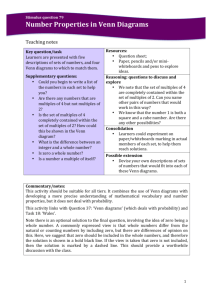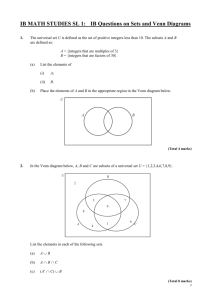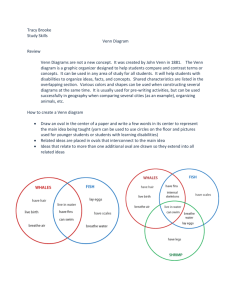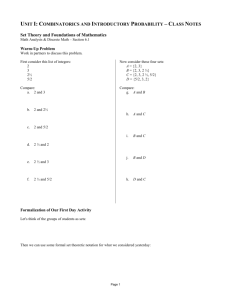Venn Diagram Math Lesson
advertisement
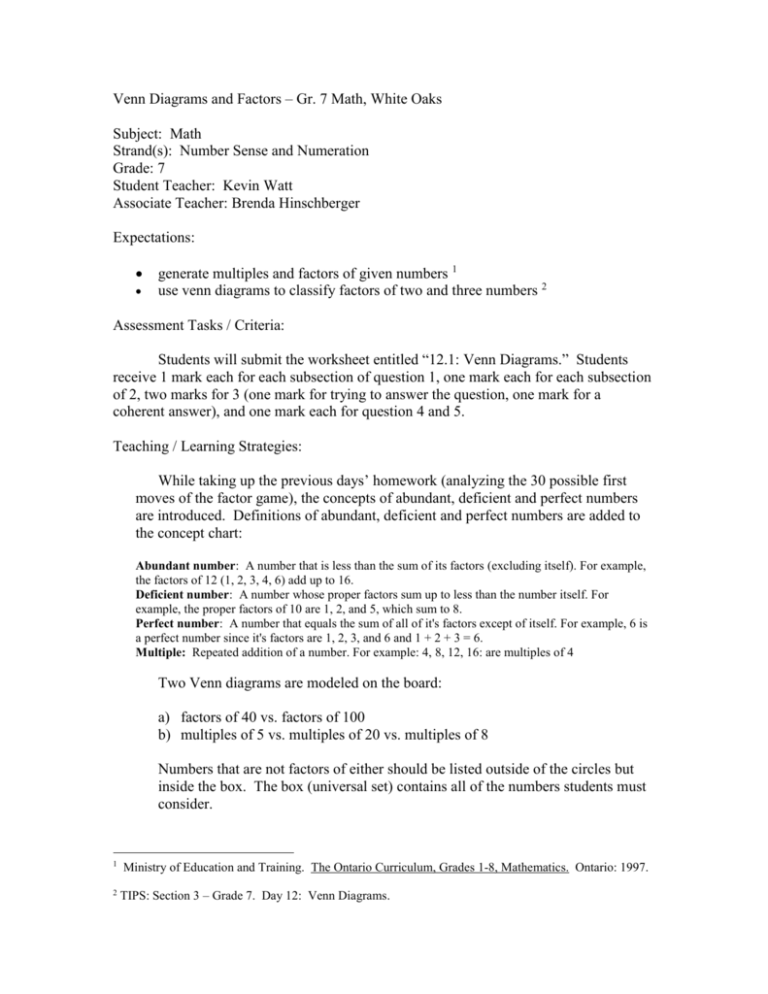
Venn Diagrams and Factors – Gr. 7 Math, White Oaks Subject: Math Strand(s): Number Sense and Numeration Grade: 7 Student Teacher: Kevin Watt Associate Teacher: Brenda Hinschberger Expectations: generate multiples and factors of given numbers 1 use venn diagrams to classify factors of two and three numbers 2 Assessment Tasks / Criteria: Students will submit the worksheet entitled “12.1: Venn Diagrams.” Students receive 1 mark each for each subsection of question 1, one mark each for each subsection of 2, two marks for 3 (one mark for trying to answer the question, one mark for a coherent answer), and one mark each for question 4 and 5. Teaching / Learning Strategies: While taking up the previous days’ homework (analyzing the 30 possible first moves of the factor game), the concepts of abundant, deficient and perfect numbers are introduced. Definitions of abundant, deficient and perfect numbers are added to the concept chart: Abundant number: A number that is less than the sum of its factors (excluding itself). For example, the factors of 12 (1, 2, 3, 4, 6) add up to 16. Deficient number: A number whose proper factors sum up to less than the number itself. For example, the proper factors of 10 are 1, 2, and 5, which sum to 8. Perfect number: A number that equals the sum of all of it's factors except of itself. For example, 6 is a perfect number since it's factors are 1, 2, 3, and 6 and 1 + 2 + 3 = 6. Multiple: Repeated addition of a number. For example: 4, 8, 12, 16: are multiples of 4 Two Venn diagrams are modeled on the board: a) factors of 40 vs. factors of 100 b) multiples of 5 vs. multiples of 20 vs. multiples of 8 Numbers that are not factors of either should be listed outside of the circles but inside the box. The box (universal set) contains all of the numbers students must consider. 1 2 Ministry of Education and Training. The Ontario Curriculum, Grades 1-8, Mathematics. Ontario: 1997. TIPS: Section 3 – Grade 7. Day 12: Venn Diagrams. Students work in pairs to complete worksheet 12.1. They should only consider numbers from 1 to 100. Identify ways to self-check their work using patterns and number sense. Each pair will join with the rest of their group to compare answers and resolve discrepancies. Each group will create two more Venn diagrams to challenge classmates, including solutions separately. In pairs, students work through the Venn diagrams created by their peers. This exercise will only occur if time allows. Finally, students will be given the quiz from page 3 of the “Ontario Math Workbook: Grade 7” to verify their understanding of factors and multiples. Accommodations / Modifications: ESL students should be given extra help with the wording of questions. They should be explicitly asked if they are having trouble with understanding the instructions given by the teacher. Theme / Topic / Resources: The topic for this lesson is “factors and multiples”. Venn diagrams are used to illustrate common factors and multiples of various numbers. Resources include: Photocopies of 12.1: Venn Diagram Blank paper for creation of each groups’ Venn Diagrams.



